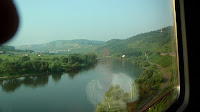



























Great day of hiking today from Schmittenhohe. There should be an oomlaut over that "o", but I don't know how to put it there. It was raining on our way up, but we hoped for a break, and got it. Saw sun, mist, clouds and rain, but overall pretty sure that we got more wet from sweat than from rain. According to Heimo, the Austrians are pretty keen hikers, and judging from what we experienced today, I have every reason to agree with him. Following Heimo's sage advice, the first thing we did this morning was to buy some walking sticks which came in very handy on the wet slippery bits of path where straw has been strewn as well as the knobbly bits of path where the roots of the mighty pines were exposed in intricate twisting networks. Also, per Heimo's excellent suggestion, we took the cable car "up" to the top (depending on which map you read, it's either 1949 meters or 2000 meters...Tissot corroborated the 1949 meter measure so that's what's going into our log...either way, it's the higest altitude we achieved this trip), and then, after a great bowl of goulash, bread, apple struddel and free coffee at the restaurant at the top, we walked back down to Zell Am See....a direction we are which we are quite sure was much more enjoyable than the equivalent upward trek...Thanks Heimo...the day would probably not have unfolded as nicely had it not been for your timely e-mail! It is worth noting, at this point, the reason for the free coffee...the lady who sold us the tickets strobgly recommended that we buy a cable-car pass both up and down. We told her we were intending to cable up and walk down, but she said the conditions at the summit were wet windy, and cold. When we asked her if she was suggesting that the descent would be dangerous, she said, the wet and slippery rocks were like this (at this point she held up both her hands and spread them apart to a distance which take a very large duffel bag to fill). So, being duly spooked, we purchased the downward fare as well only to discover at the top that it wasn't nearly as bad as the ticket lady (as polite and pleasant as she truly was), and we decided to walk down despite the unfavourable odds she had described. I suspect that she has never been down the path herself, or she would have realized how marvelously easy it is. The path down took us a little over 3 hours of very good, sometimes steep, but almost always well groomed and well marked trails to the bottom. The views between the drifting clouds were marvelous and inspiring. The pines were tall and nobly silent...with the exception of the occasional gurgling brook, we can't recall hearing any sounds neither birds ror any other animals in the area...maybe they the rain has a soporific upon those who inhabit the forest. The smell of the wet pines and the rich dark wet earth filled the noiseless void with a sweet woody aroma. I'm quite certain that I have never seen as many lupens in all my accumulated years as the ones we saw today. The Lupens were everywhere and in great numbers and, oddly, all sporting the same mauve colour. There is a lovely little chapel on top of the summit called St Elizabeth Kappel, built a little over 100 years ago. Wherever we go, we We are finding endless opportunities to say little prayers everywhere we go, big cities, little towns, and at the tops of 2000m mountain peaks. Peace and goodwill to all our patient and long suffering readers.






















